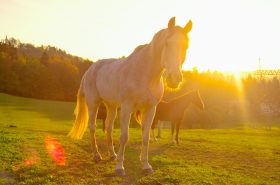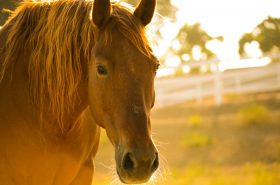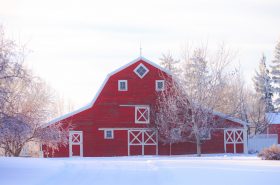It’s also one of the few things that even a non-horsey person can appreciate when visiting your barn.
A clean stall shows up front that you take care of your facility and your horses. A clean stall is also one of the best places to start looking if you think your horse may be ill. By having a clean stall to evaluate, you’ll be able to learn your horse’s patterns. You’ll know whether he is neat or messy and how many piles he’ll usually put out over a certain amount of time, such as overnight. Horses eliminate about every three hours, so don’t be surprised to see three or four piles in a stall that was spotless when you put your horse away the night before.
Horses will also urinate on a regular basis, so make sure there is enough bedding to soak it up so your horse isn’t standing in puddles. While some subscribe to the theory of allowing urine to drain through the floor, I do not find this to be particularly healthy. Walk through a barn where this is the practice, and you will find that the ammonia smell is strong. Think of how this would affect your horse with his ultra-sensitive nose. If the floor of the stall is sand, it probably is slippery and has pits and low spots from being dug out. If the floor is a mat with drainage holes, urine-soaked bedding may clog those holes, and it is almost impossible to clear them.
I have cleaned stalls with floors of concrete, sand, dirt, wood, and mats. Over time, I have learned that a floor with a good, well-fitting stall mat that lies flat has always been the easiest to clean.
I’ve tripped over mats that have curled, dug up spikes that affixed thin, lightweight mats to the floor, caught fork tines on wood flooring, and used way too much bedding to make up for a hard concrete floor. Where wet spots have been dug out of sand or dirt floors, there is a tendency to waste excessive amounts of bedding filling in holes and pits. Even when a stall looks level to a human, it is anything but to the feet of the horse. Uneven flooring is stressful to a horse’s legs and feet.
For the most part, when cleaning a stall, you want to remove the manure and wet spot bedding while salvaging as much good bedding as possible. The constant challenge to horse owners is finding the best way to go about this chore. Whether you bed with straw or shavings, a few simple tools make all the difference.
An apple-picker with a raised back and sides is a great for cleaning stalls bedded with shavings.
The raised edges allow you to shake out clean bedding while retaining manure. Pitchforks work better for straw beds; three or four sturdy tines are best.
Take a wheelbarrow or muck bucket into the stall with you to avoid having to sling bedding into a spreader parked in the barn aisle. Try to plan your barn to give easy access to your manure pile.
Now that you are properly equipped, it’s time to get started.
How you start will depend on each horse’s habits. If your horse is neat and puts everything in one corner, start by simply scooping out the manure.
For horses this tidy, you can even cut back on the bedding that goes in that corner of the stall.
Next, find the wet spot. Generally it’s in the back of the stall for mares and in the center for geldings and stallions.
With mat flooring, your fork or picker will slide easily under the bedding. The wet spot may be a couple feet across; be sure to get it all.
Aerating the remaining bedding is the next step, and is generally the same for both shavings and straw.
Use your fork to “flip” the bedding up and pile it against the wall of the stall. Anything solid that might have been missed will roll to the base of the pile. Remove the solids. Pull the bedding back down, making sure plenty of bedding covers where the wet spot tends to be. Pull the bedding in from the sides of the stall.
A messier horse’s stall is cleaned pretty much the same way, although starting with the wet spot is easier.
The messier horse has probably left a few piles at various spots on his floor. Some of the piles may have been dragged apart from being stepped on during the night. Pick up these piles after the wet spot has been removed.
Now, rather than digging through with your fork to find the rest, let gravity go to work for you. Start aerating the bedding, flip it up against the wall and allow the solids to roll to the floor. It may take a few flips to get all the solids, but trust me, gravity works. With an apple picker, solids can be easily gathered. Once these are removed, pull the old bedding down to the center of the stall.
It is a good practice to add new bedding along the walls. The old bedding has been rotated into the center so it can be used first. Putting the new bedding along the sides and walls is called “banking.” When bedding with straw, make sure to thoroughly separate the bale sections so the horses don’t slip on them. When deciding how much bedding to add, remember to have enough to soak up the urine.
One of the myths associated with using stall mats is that less bedding can be used.
That’s really not accurate. The savings with using a good mat comes from removing less material from the stall when cleaning.
As you are not digging up a dirt floor, you’re not taking out as much. Plus, a non-porous mat does not absorb odor. No odor means healthier lungs for your horse as well as a more pleasant environment.
Before you exit the stall, smooth the bedding flat. Your horse will move the bedding to where he wants it. One last thing before you walk out–is your stall now clean enough that you’d sit in it? If it’s good enough for you, then it’s ready for your horse. Horses appreciate cleanliness.
Yes, cleaning a stall is a chore, but one that must not be skipped. Daily cleaning saves on bedding and labor. A clean stall is healthier for a horse’s lungs and feet.
Proper technique speeds up the procedure, as well as saves money on bedding. Proper equipment is worth every penny, cutting down the time spent in the stall. Getting a new wheelbarrow may not be as exciting as picking out a new saddle, but I can guarantee you that the wheelbarrow will help you spend more time in that saddle.
Chores can be sooo much easier (and FUN!) with our 8’ Overland electric wheelbarrow! 🙌🐴🐓You can learn more about them here: http://www.rammfence.com/farm/electric-wheelbarrows/electric-wheelbarrow
Posted by RAMM Horse Fencing & Stalls on Wednesday, December 20, 2017




